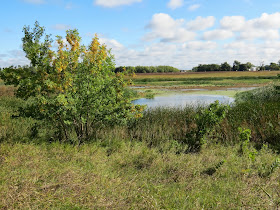We have had a relatively early start to winter here in the
Sioux Falls area. It has been
quite cold and snowy here the past two or three weeks, and it seems likely that
the snow cover over my favorite hiking areas will only increase over the next
three months.
Today seemed like a good day to get my snowshoes out and
take a hike at the Perry Nature Area/Mary Jo Wegner Arboretum. This has been one of our favorite
hiking areas over the years; it is also where I have tended use my snowshoes
whenever I felt the urge to walk about the landscape and observe winter
conditions.
Many years ago, when I got my bent-wood, rawhide, Sergeant
Preston-type snowshoes, I felt like an outdoorsman, an adventurer walking along
snow-covered terrain in my isolation.
Today, these snowshoes seem quaint to younger people. The aluminum, modern snowshoes with
easy to attach straps are so much handier to use and have popularized
snowshoeing.
Much more effort is required in snowshoeing than just
strolling along on paths through the woods. At this time of year, such a workout helps reduce the
“winter weight” that seems to stretch out our waistline. It also offers a good alternative to
“going to the gym” and working out on machines. Going to the gym is, to me, always the last option, one that
I have avoided the past few years in favor of hiking, kayaking, biking, and now
snowshoeing.
On my stroll this morning, I ran across a couple of guys on
cross-country skies and another couple of guys with four big dogs romping in
the snow. For the most part,
however, snowshoeing can be a solitary activity that offers an opportunity to
look at the tracks of wildlife, observe the way snow covers the landscape, and check
out the trees, bushes, and tall grass as they settle in for the winter months.
Perry Nature Area and the Arboretum are just on the east
edge of Sioux Falls and provide a great location for snowshoeing and
cross-country skiing. I walked
along in the path of others who had recently taken the same route along the
margin between the grasslands and the wooded area on the edge of the Big Sioux
River.
I will continue using my snowshoes over the course of the
winter. The Outdoor Campus in
Sioux Falls offers lessons and snowshoes for those interested in trying out
this aspect of winter hiking.






















































